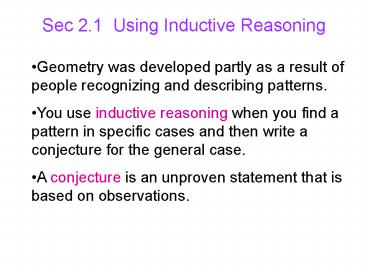Sec 2'1 Using Inductive Reasoning - PowerPoint PPT Presentation
1 / 12
Title:
Sec 2'1 Using Inductive Reasoning
Description:
You use inductive reasoning when you find a pattern in specific cases and then ... A conjecture is an unproven statement that is based on observations. EXAMPLE 1 ... – PowerPoint PPT presentation
Number of Views:32
Avg rating:3.0/5.0
Title: Sec 2'1 Using Inductive Reasoning
1
Sec 2.1 Using Inductive Reasoning
- Geometry was developed partly as a result of
people recognizing and describing patterns. - You use inductive reasoning when you find a
pattern in specific cases and then write a
conjecture for the general case. - A conjecture is an unproven statement that is
based on observations.
2
EXAMPLE 1
Describe a visual pattern
SOLUTION
3
EXAMPLE 2
Describe a number pattern
Describe the pattern in the numbers 7, 21, 63,
189, and write the next three numbers in
the pattern.
4
Given five collinear points, make a conjecture
about the number of ways to connect different
pairs of the points.
EXAMPLE 3
SOLUTION
Make a table and look for a pattern. Notice the
pattern in how the number of connections
increases. You can use the pattern to make a
conjecture.
Conjecture You can connect five collinear points
6 4, or 10 different ways.
5
(No Transcript)
6
- To show that a conjecture is true, you must show
that it is true for all cases, which can be
nearly impossible. - You can show that a conjecture is false, however,
by simply finding one counterexample. - A counterexample is a specific case for which the
conjecture is false.
7
EXAMPLE 5
Find a counterexample
A student makes the following conjecture about
the sum of two numbers. Find a counterexample to
disprove the students conjecture.
Conjecture The sum of two numbers is always
greater than the larger number.
SOLUTION
To find a counterexample, you need to find a sum
that is less than the larger number.
8
EXAMPLE 5
Find a counterexample
Conjecture The sum of two numbers is always
greater than the larger number.
2 3
5
9
EXAMPLE 6
Standardized Test Practice
10
EXAMPLE 6
Standardized Test Practice
SOLUTION
Choices A and C can be eliminated because they
refer to facts not presented by the graph. Choice
B is a reasonable conjecture because the graph
shows an increase from 19902001, but does not
give any reasons for that increase.
11
for Examples 5 and 6
GUIDED PRACTICE
Conjecture The value of x2 is always greater
than the value of x.
12
HomeworkWorksheet 2.1































